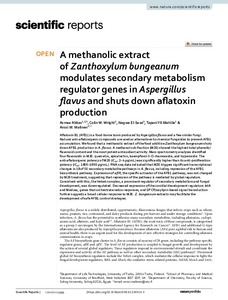A methanolic extract of Zanthoxylum bungeanum modulates secondary metabolism regulator genes in Aspergillus flavus and shuts down aflatoxin production
Malinen Anssi M; Yli-Mattila Tapani; Wright Colin W; ElSawi Nagwa; Abbas Asmaa
https://urn.fi/URN:NBN:fi-fe2022081154480
Tiivistelmä
Aflatoxin B1 (AFB1) is a food-borne toxin produced by Aspergillus flavus and a few similar fungi. Natural anti-aflatoxigenic compounds are used as alternatives to chemical fungicides to prevent AFB1 accumulation. We found that a methanolic extract of the food additive Zanthoxylum bungeanum shuts down AFB1 production in A. flavus. A methanol sub-fraction (M20) showed the highest total phenolic/flavonoid content and the most potent antioxidant activity. Mass spectrometry analyses identified four flavonoids in M20: quercetin, epicatechin, kaempferol-3-O-rhamnoside, and hyperoside. The anti-aflatoxigenic potency of M20 (IC50: 2–4 µg/mL) was significantly higher than its anti-proliferation potency (IC50: 1800–1900 µg/mL). RNA-seq data indicated that M20 triggers significant transcriptional changes in 18 of 56 secondary metabolite pathways in A. flavus, including repression of the AFB1 biosynthesis pathway. Expression of aflR, the specific activator of the AFB1 pathway, was not changed by M20 treatment, suggesting that repression of the pathway is mediated by global regulators. Consistent with this, the Velvet complex, a prominent regulator of secondary metabolism and fungal development, was downregulated. Decreased expression of the conidial development regulators brlA and Medusa, genes that orchestrate redox responses, and GPCR/oxylipin-based signal transduction further suggests a broad cellular response to M20. Z. bungeanum extracts may facilitate the development of safe AFB1 control strategies.
Kokoelmat
- Rinnakkaistallenteet [19248]
